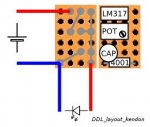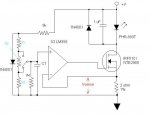I'm considering using rkcstar's adjustable driver in the 30-150 mA range for my 803t build. My questions are as follows: First, is it safe to tune a running diode? Second, at this approximately specified current range, could I basically run an 803t at min->max current supplied by this driver safely? Third, does the potentiometer"lock" when I have reached its min/max setting? Fourth, even if I can't tune the diode continuously as it runs, could I tune this driver just using the 803t diode and a DMM instead of with a test load? And finally, is it safe to run the 803t diode at or near the minimum lasing threshold? I ask these questions mainly because I'd like to be able to run this diode at low mW output for normal use, but have the option of running it near maximum output for short periods of time as well.
Thanks in advance for any answers given.
Thanks in advance for any answers given.









